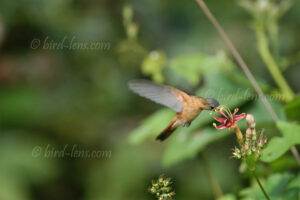 This beautiful scene of a hummingbird hovering in front of a purple-red flower is a common sight in the tropics. Seemingly weightless, the hummingbird, a Cinnamon Hummingbird (Amazilia rutila), sips nectar. This photo even made it into a Science article published on May 6, 2004.
This beautiful scene of a hummingbird hovering in front of a purple-red flower is a common sight in the tropics. Seemingly weightless, the hummingbird, a Cinnamon Hummingbird (Amazilia rutila), sips nectar. This photo even made it into a Science article published on May 6, 2004.
Ironically, in comparatively cool Germany, in a clay pit in Frauenweiler south of Heidelberg, ornithologists came across the first traces of hummingbirds in the Old World. Gerald Mayr PhD from the Senckenberg Research Institute in Frankfurt examined the bones and named the extinct species “Eurotrochilus inexpectatus“. That means something like “Unexpected European variant of Trochilus”.
Eurotrochilus inexpectatus lived about 30 million years ago. The oldest hummingbird fossils to date come from South America and are only around a million years old, the ornithologist writes in the science magazine Science.
Today hummingbirds are only known from America. However, their long-extinct European relatives were just as tiny and also had the typical elongated beak for sucking nectar and another characteristic skeletal feature: their shoulder joints and upper arm bones were also built in such a way that the bird, like modern hummingbirds, can rotate its wings and thus sip nectar hovering in the air could drink from calyxes.
That hummingbirds also existed in the Old World could explain how the shape of some Asian and African flowers, which have a very beak-friendly shape but grow without branches, came about. They could have evolved together with the tiny, hovering birds, Mayr suspects. When the hummingbirds then disappeared from the scene, insects took over the pollination tasks of the dainty birds, the biologist speculates.
Bird-lens is primarily a website designed to meet the growing demand for high-quality photographs of the birds of the Western Palearctic. In order to satisfy the demand for top-quality photographs of rare bird species, Bird-Lens.com has also made targeted trips to distant places such as Asia, Africa and the Americas. All this in order to be able to take excellent photos of birds. The yield of pictures not only of rare Western Palearctic birds is very good. The beautiful action image of the blog is only a first impression, what you can find in behind the tab “Picture Shop” very soon. Just leave a message if bird-lens.com can serve with a picture.